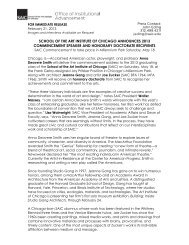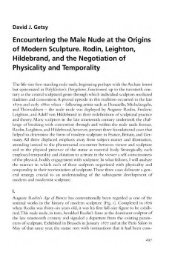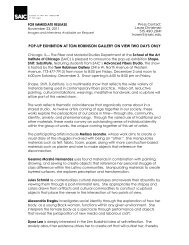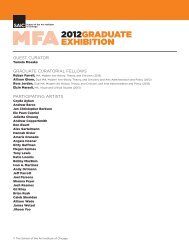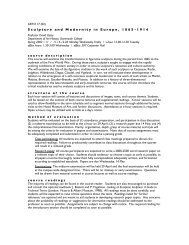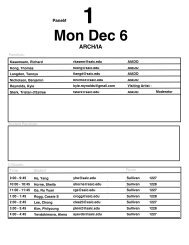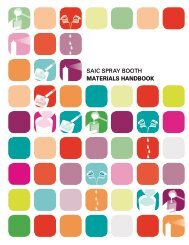i. institutional support and commitment to continuous improvement
i. institutional support and commitment to continuous improvement
i. institutional support and commitment to continuous improvement
You also want an ePaper? Increase the reach of your titles
YUMPU automatically turns print PDFs into web optimized ePapers that Google loves.
I. Institutional Support <strong>and</strong> Commitment <strong>to</strong> Continuous Improvement<br />
Helen Maria Nugent, SAIC Professor <strong>and</strong> Direc<strong>to</strong>r, Designed Objects<br />
Jan Tichy, artist Carol Ehlers, Adjunct Professor, Columbia College Chicago<br />
Sharing reflections on the experimental light work of László Moholy-Nagy, Nugent <strong>and</strong><br />
Tichy discussed their collaborative installation, Delineations. They were joined by Ehlers,<br />
guest cura<strong>to</strong>r for “Moholy: An Education of the Senses.”<br />
o “View-Master <strong>and</strong> the Art of Industrial Design”—Oc<strong>to</strong>ber 19, 2009<br />
Charles Harrison, designer <strong>and</strong> SAIC Senior Lecturer, Designed Objects<br />
Martin Thaler, designer <strong>and</strong> Associate Professor, Institute of Design, IIT<br />
Both speakers redesigned the View-Master: Harrison transforming earlier versions in<strong>to</strong><br />
the object we recognize <strong>to</strong>day; Thaler reimagining it on its 50th anniversary. While shar-<br />
ing their experiences within the his<strong>to</strong>ry of this iconic <strong>to</strong>y, they also provided insight in<strong>to</strong><br />
the design process under the governance of industry.<br />
o “Always After (The Glass House)”—Oc<strong>to</strong>ber 26, 2009<br />
Iñigo Manglano-Ovalle, artist Lisa Dorin Assistant Cura<strong>to</strong>r of Contemporary Art, AIC<br />
Manglano-Ovalle’s film, Always After (The Glass House), abstractly chronicled a recent<br />
jarring moment in Mies van der Rohe’s architecture. Dorin <strong>and</strong> the artist discussed the<br />
foundations of this work <strong>and</strong> its recent acquisition by the Art Institute.<br />
o “Mind-Mapping Modernity”—November 2, 2009<br />
Mika Hannula, Professor in Artistic Research, University of Göteborg, Sweden<br />
This presentation—as much performance as academic lecture—traced connections be-<br />
tween theories of modernity <strong>and</strong> their evolution over time in a mind-mapping exercise.<br />
o “Bio-line”—November 9, 2009<br />
Walter Hood, Professor, L<strong>and</strong>scape Architecture <strong>and</strong> Environmental Planning, UC Berkeley<br />
Christy Matson, SAIC Assistant Professor, Fiber <strong>and</strong> Material Studies<br />
Andrew Yang, SAIC Assistant Professor, Liberal Arts <strong>and</strong> Visual <strong>and</strong> Critical Studies<br />
A l<strong>and</strong>scape architect, a specialist in textile patterning, <strong>and</strong> a research biologist deployed<br />
their collective expertise <strong>to</strong> analyze the issues of fabrication, aesthetics, <strong>and</strong> symbiosis that<br />
are integral <strong>to</strong> the design <strong>and</strong> function of Bio-Line, an interior-systems pro<strong>to</strong>type.<br />
o “Knowledge Box Re-created”—November 16, 2009<br />
Ken Isaacs, architect <strong>and</strong> designer<br />
Vic<strong>to</strong>r Margolin, Professor Emeritus, Design His<strong>to</strong>ry, University of Illinois, Chicago<br />
Susan Snodgrass, project cura<strong>to</strong>r, SAIC Department of Sculpture <strong>and</strong> New Arts Journalism<br />
This panel considered the his<strong>to</strong>ry of Isaacs’s work <strong>and</strong> its current presentation: Knowl-<br />
edge Box, an immersive learning environment originally constructed in 1962; <strong>and</strong><br />
populist-oriented design for “Living Structures,” reinterpreted here by a student team<br />
from SAIC.<br />
o “Modern Technologies”—November 23, 2009<br />
Mark Anderson, artist; John Manning, SAIC Associate Professor, Art <strong>and</strong> Technology<br />
Douglas Pancoast, SAIC Associate Professor <strong>and</strong> Graduate Program Direc<strong>to</strong>r, AIADO<br />
New technologies that are revolutionizing the capabilities <strong>and</strong> intersections of architec-<br />
tural <strong>and</strong> artistic practice—hallmarks of the modern world—were discussed in relationship<br />
<strong>to</strong> Infinite Sprawl, an installation allowing visi<strong>to</strong>rs <strong>to</strong> manipulate an ever-changing digital<br />
cityscape.<br />
o “EUREKA! What Was Going On In Mohol-Nagy’s Brain When He<br />
Changed Strategies <strong>and</strong> Designed the Bauhaus Curriculum?”<br />
—November 30, 2009<br />
Ronald Jones, Professor of Interdisciplinary Studies, Konstfack, University College of Art, S<strong>to</strong>ckholm<br />
Creative decision making nearly always produces an interdisciplinary mapping of ideas in the brain as<br />
you come <strong>to</strong> a “breakthrough <strong>and</strong> creative” decision. This talk looked at Moholy-Nagy’s pedagogical<br />
79 | Spring 2011<br />
SECTION I Institutional Support <strong>and</strong> Commitment <strong>to</strong> Continuous Improvement



